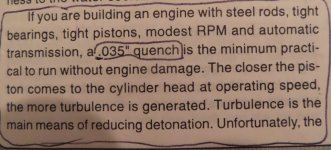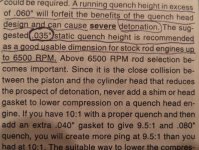Anyone have a concise (i.e. easy) method to calculate DCR? I'm struggling with "Quench", head gasket selection, etc. for my '67 L78 build. My SCR will be 11.5 to 11.6:1 if I worry about quench and stay with a shim gasket thickness (0.020"+/-), or go with a Fel-Pro .039" thick composite gasket (My preference, which hypothetically will yield 11:1 SCR)....I am assuming .020" in the hole since my block has not been assembled yet (still waiting on my 38.8 cc domed pistons).
I'm told DCR is more important when analyzing how well the engine might run on 93 octane than merely looking at SCR. My Howards cam is identical to a stock L78 flat tappet cam except for slightly more "lift". A friend on TC has an already built '69 L78 engine which I am following somewhat with respect to main elements of the build, including the cam, block & 840 heads, and his '69 L78 runs swell on 93 octane with the Fel-Pro .039" gasket and quench of about .063. I believe the DCR is one reason for this.
So, any help on this would be appreciated. I've reviewed the one calculation article that I found on TC, but honestly, it's a bit confusing for a novice! I believe in "kiss"!
I believe in "kiss"!
Thanks,
John
I'm told DCR is more important when analyzing how well the engine might run on 93 octane than merely looking at SCR. My Howards cam is identical to a stock L78 flat tappet cam except for slightly more "lift". A friend on TC has an already built '69 L78 engine which I am following somewhat with respect to main elements of the build, including the cam, block & 840 heads, and his '69 L78 runs swell on 93 octane with the Fel-Pro .039" gasket and quench of about .063. I believe the DCR is one reason for this.
So, any help on this would be appreciated. I've reviewed the one calculation article that I found on TC, but honestly, it's a bit confusing for a novice!
Thanks,
John


